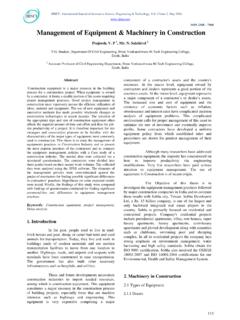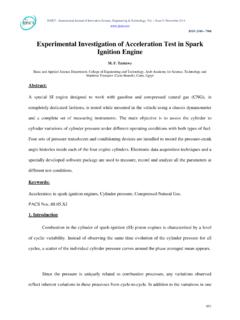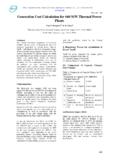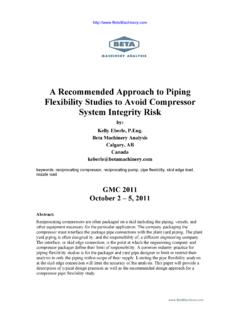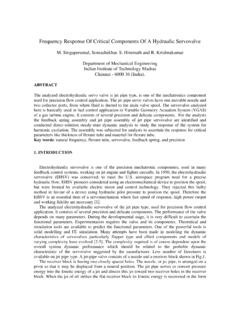Transcription of Design, Analysis and Experimental Verification of ...
1 IJISET - International Journal of Innovative Science, Engineering & Technology, Vol. 1 Issue 10, December 2014. ISSN 2348 7968 design , Analysis and Experimental Verification of Torispherical Head and Toriconical Bottom Pressure Vessel Dr. M. M. Patil1, Dr. Lokesh Bajpai2 1 Mechanical Engineering Department, J. T. Mahajan College of Engineering Faizpur, Maharashtra State, 425524, India, 2 Mechanical Engineering Department, SATI Vidisha, Madya Pradesh State, India, Abstract The significance of the title of this paper to highlight designing structure of the pressure vessel for static loading and its assessment using ANSYS and Experimental setup. This work is concerned with design of different pressure vessel elements such as shell, torispherical head, toriconical bottom, operating nozzle, its reinforcement, on standards and codes and evolution of all components analyzed by ANSYS and Experimental setup.
2 This study addresses the problem of pressure vessel using both Experimental and Finite Element Analysis (FEA) approach. When pressure vessels are designed using traditional methods they often suffer permanent volume expansion at the bottom end closure and become unstable when they are pressure tested experimentally. In this work, Experimental investigations are carried out using hydrostatic pressure tests with water. In the case of numerical investigations, the FEA models are constructed using material SA240 Gr 316. The results obtained from both FEA models and Experimental tests are compared which shows close agreement. Keywords: FEA, Torispherical Head, Pressure Vessel 1. Introduction The design of pressure vessels requires a careful study of many regions, the most critical of which is the knuckle region.
3 Torispherical heads and Toriconical bottom with various knuckle radii (for each head height) have been investigated by researchers to establish an optimum' Torispherical head and Toriconical bottom. The effect of axial loads, external pressure and thermal loads on stiffened cylindrical shells has also been investigated in the past. Theoretical and numerical calculation of stress at stress concentration points of both torispherical and ellipsoidal heads have also been investigated in previous researches and a complete method for using reinforcement plates in these points has been addressed in ASME codes. No standard code or procedure has addressed the application of toriconical bottom on heads subjected to either external or internal pressure. On the other hand, reduction of even 1mm in the thickness of a head can sometimes have a great impact on the total costs of a head.
4 For example, in the case of a design recommending the application of a 26mm plate for a head, because of the market limitation, the manufacturer may order a 30mm thickness plate. The application of a stiffening-ring could be an alternative solution for the application of a thinner plate, eg a 25mm plate instead of a 30 mm one. Fig. 1 Torispherical head and toriconical bottom vessel. Shell design If a thin circular cylinder is subjected to the action of radial forces uniformly distributed along its circumference, hoop stress will be produced throughout its thickness in tangential direction as given by, H = Pr /t, L = Pr / 2t Where P = Internal Pressure, r = Radius of shell, t=Thickness H = Hoop stress , l = Longitudinal stress Taking fabrication and inspection quality into account, ASME has suggested modified formula for finding thickness for given pressure.
5 I) Circumferential stress (Longitudinal Joint) t = PR / (SE P) or p = SET / (R + ) design Data Operating pressure = N/mm2 (shell side) design pressure = N/mm2 Inside diameter = 1230 mm Shell material SA 204 423 IJISET - International Journal of Innovative Science, Engineering & Technology, Vol. 1 Issue 10, December 2014. ISSN 2348 7968 Permissible stress , S = N/mm2 Assume welding efficiency, E = = 6. (Repeated load applied gradually but not reversed) Shell Thickness: For circumferential stress Fig. 2 Hoop stresses in the shell. Thickness = = = Thickness of Shell is considered 8 mm. Height of shell is 2000mm. Outer diameter of shell is 1246mm. design of Torispherical Head (Thickness Calculation) Material: use SA240 Gr 316, E =1, Allowable stress , S = N/mm2. design Pressure = 8 Kgf/cm2 According to UG 31 of ASME Sec VIII Div 1, Fig.
6 3 Torispherical head. The stress intensification factor, W, is given W= W= = Thickness of Head S= = = Thickness of Torispherical head is considered 12 mm. Where P= Internal pressure Rc = Crown Radius Ri= Knuckle Radius W= stress intensification factor. S=Thickness of Head. = 60mm = mm Total Height (H) = = 60+ = mm. Knuckle radius is 10% of Crown radius that is 123mm. Toriconical Bottom (Thickness Calculation) Material: use SA240 Gr 316, E =1, Allowable stress , S = 70 N/mm2. P = Kgf/cm2. Fig. 4 Toriconical bottom. Thickness = Thickness = Thickness = Thickness = mm Thickness of Toriconical bottom is 12mm 424 IJISET - International Journal of Innovative Science, Engineering & Technology, Vol. 1 Issue 10, December 2014. ISSN 2348 7968 2. Finite Element Analysis of Pressure Vessel Because of the complicated shape of the shell, stress Analysis by using photo-elasticity will also be difficult.
7 stress Analysis by finite element method is obviously the best choice. Hence finite element technique has been selected for the Analysis purpose. There are different types of commercial FEM software available in the market. ANSYS FEM software is one of the most popular commercial software is used for the Finite element Analysis of the pressure vessel. The material used for the construction of pressure vessel is SA240 and its properties are as shown in Table 1. Table 1: Material properties SA240 Sr. no Properties Values 1 Modules of elasticity 2 x 105 N/mm2 2 Poison s ratio 3 Yield stress 205 N/mm2 4 Tensile stress 505 N/mm2 5 Density of material 8000 Kg/m3 Modeling is done on the solid works with the actual industrial design data and during modeling all inlet-outlet is considered for the particular problem, the model was prepared by using solid works graphic software as shown in Figure-5.
8 Fig. 5 Geometric model of head with shell and having toriconical bottom. CASE-I Actual Industrial model Analysis on ANSYS: Analysis of the model is done on based on actual industrial model. In this model shell and head is connected with the flat flange. During the Analysis operating pressure and operating condition is considered as per actual industrial model. Testing Pressure -8 kgf/cm2 Fig. 6 Analysis of actual industrial pressure vessel head with the flat flange Analysis of Shell and Bottom with flat flange: Testing Pressure -8 kgf/cm2 Fig. 7 Analysis of actual pressure vessel shell with the flat flange CASE-II Modified Pressure Vessel Analysis on Ansys: The modified model is similar to earlier pressure vessel used in industry except flange design . Flange design used for shell and head connection is changed from flat flange to hub flange.
9 Testing Pressure -8 kgf/cm2 425 IJISET - International Journal of Innovative Science, Engineering & Technology, Vol. 1 Issue 10, December 2014. ISSN 2348 7968 Fig. 8 Analysis of head on the Ansys for hub flange. Analysis of Shell and Bottom with Hub flange: Testing Pressure -8 kgf/cm2 During the shell Analysis all data is same as actual data but in place of flat flange hub flange is considered. Fig. 9 Analysis of head on the Ansys for hub flange hub. 3. Experimental Analysis of Pressure Vessel Electrical Resistance strain Gauges are metallic resistors that can be pasted onto the surface of a part on which you want to measure strain. When the part deforms the strain gauge deforms along with it. This deformation is reflected as a proportional change in the resistance of the strain gauge. Figure-11 shows the actual arrangement of Experimental setup in this setup actual pressure vessel is connected with the strain gauge measurement system and strain gauge system is connected with the strain gauges.
10 During the Analysis strain is measured in micron and that strain is converted in to stress with help of young modulus of the material. Fig. 10 Electrical strain gauge on shell. Fig. 11 Strain measurement with pressure vessel. Observations: Following observations are found during operating conditions. Circumferential Stresses in shell: From mechanics of material laboratory:- E- Young s Modulus (for E= 2x105 N/mm2 ) v- Poisons ratio = for v= ) c = E X eh = 2x105 x 395 x 10-6 =79 N/mm2 Circumferential Stresses in Bottom: c = E X eh = 2x105 x 248 x 10-6 = N/mm2 Stresses in Head c= E X eh =2x105 x 405 x 10-6 =81 N/mm2 426 IJISET - International Journal of Innovative Science, Engineering & Technology, Vol.

